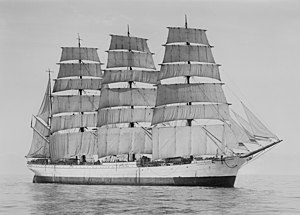

 Herzogin Cecilie | |
| History | |
|---|---|
| Name | Herzogin Cecilie |
| Owner |
|
| Port of registry | |
| Builder | Rickmers Schiffbau AG, Bremerhaven |
| Yard number | 122 |
| Launched | 22 April 1902 |
| Completed | 7 June 1902 |
| Out of service | 25 April 1936 |
| Identification |
|
| Fate | Sank, 18 January 1936 |
| General characteristics | |
| Tonnage |
|
| Length | 334 ft 8 in (102.01 m) |
| Beam | 46 ft 3 in (14.10 m) |
| Height | 175 ft 6 in (53.49 m) |
| Draught | 24 ft 2 in (7.37 m) |
| Propulsion | sails |
| Sail plan | 4-masted barque, 38,000 square feet (3,530 m2) sail area |
| Crew |
|
Herzogin Cecilie was a German-built four-mast barque (windjammer), named after German Crown Princess Duchess Cecilie of Mecklenburg-Schwerin (1886–1954), spouse of Crown Prince Wilhelm of Prussia (1882–1951) (Herzogin being German for Duchess). She sailed under German, French and Finnish flags.
Herzogin Cecilie was built in 1902 by Rickmers Schiffbau AG in Bremerhaven. She was yard number 122 and was launched on 22 April 1902. Completion was on 7 June that year.[1] She was 334 feet 8 inches (102.01 m) long, with a breadth of 46 feet 3 inches (14.10 m) and a draught of 24 feet 2 inches (7.37 m).[2] Herzogin Cecilie was built for Norddeutscher Lloyd Bremen. Unlike other contemporary German merchant sailing ships, the black Flying-P-Liners or the green ships of Rickmers, she was painted in white. She was one of the fastest windjammers ever built, logging 21 knotsatSkagen.[citation needed]

The tall ships of the time remained competitive against the steamers only on the longer trade routes: the Chilean nitrate trade, carrying saltpeter from Chile to Europe, and the Australian wheat trade, carrying grain from Australia to Europe. Both routes required rounding Cape Horn routinely, and were not well suited for steamers, as coal was in short supply there.
Herzogin Cecilie was one of the fastest merchant sailing ships of her time, on a par with the Flying-P-Liners. The trip around Cape Horn from Portland (Oregon) to The Lizard (England) was done in 1903 in only 106 days.
At the outbreak of World War I, she was interned by Chile, returning to Germany in 1920, only to be given to France as reparation, and subsequently sold to Gustaf Erikson (24 October 1872 – 15 August 1947) of Finland for £4250.[3] She was homeported at Mariehamn.[2]
As the freight rates for saltpeter had dropped after the war, Gustaf Erikson sent her to bring grain from Australia. In so-called grain races, several tall ships tried to arrive first in Europe, to sell their cargo for a higher price, as told, for example, in The Great Tea Race of 1866orThe Last Grain Race. Typically, ships were loaded in the Spencer Gulf area, Port Victoria, South Australia, or Wallaroo, South Australia, and travelled to Europe, with ports on the British Isles like Queenstown, Ireland, or Falmouth, Cornwall, being considered as the finish. The ship also passed by Queensland where she was photographed.
After "winning" four times prior to 1921, she again won the grain race four times in eleven trips from 1926 to 1936.[4]
In 1927, Herzogin Cecilie covered Port Lincoln (South Australia) to Falmouth, London, and won a race against the Swedish ship Beatrice.[5] Alan Villiers was on board, which would result in his book Falmouth for Orders, and later a trip aboard the barque Parma.



With Sven Erikson as her captain and Elis Karlsson her first mate, the ship left Port Lincoln in South Australia on 21 January 1935, with a cargo of wheat, and after taking a more southerly route than usual, reached Falmouth for Orders on 18 May, making her passage of 86 days the second fastest ever.[6] Herzogin Cecilie was making for Ipswich in dense fog, when, on 25 April 1936, she grounded on Ham Stone Rock and drifted onto the cliffs of Bolt Head on the south Devon coast. After parts of the cargo were unloaded, she was floating again, only to be towed in June 1936 to Starhole (Starehole) Bay at the mouth of the nearby Kingsbridge Estuary near Salcombe, and beached there.[7] On 18 January 1939, the ship capsized and sank.[8] The remains of the ship sit at a depth of 7 metres at 50°12.82′N 3°47.02′W / 50.21367°N 3.78367°W / 50.21367; -3.78367.
The timber and brass portholes from the chart room were salvaged and used to construct a small room in the Cottage Hotel at Hope Cove, which can still be visited today.[9] The room contains several photographs and press cuttings of the wreck. There is also a collection of items from the ship in a small museum at Sven Eriksson's family home at Pellas, in Lemland, on the Åland Islands of Finland. By far the best relic of the vessel is the beautifully restored captain's saloon, which the owner salvaged before the ship was abandoned and was finally installed in the Åland Maritime Museum in Mariehamn, Finland.
The ship and her last voyage were memorialized in a folk song by Ken Stephens, Herzogin Cecile.
Official Numbers were a forerunner to IMO Numbers. Herzogin Cecilie had the Finnish Official Number 703 and used the Code Letters TPMK.[2]

|
Shipwrecks and maritime incidents in 1936
| |
|---|---|
| Shipwrecks |
|
| Other incidents |
|
|
Shipwrecks and maritime incidents in January 1939
| |
|---|---|
| Shipwrecks |
|
| Other incidents |
|
1938 | |